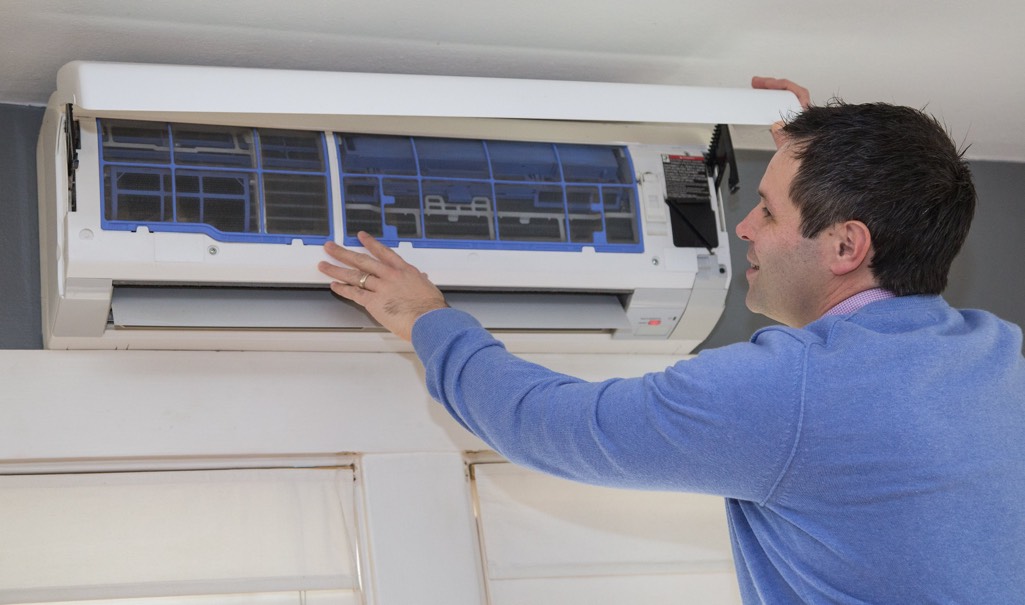Ducted vs ductless heat pump
Heat pumps take heat from outside your home and distribute it inside. A ducted heat pump uses a central air handler and network of ducts throughout your home to do this. A ductless (or mini-split) functions as a stand-alone unit with a direct link to an outside compressor.
Let’s examine the difference a bit more below.
What is a heat pump?
A heat pump is a device that takes heat from outside your home and distributes it inside. Air source heat pumps take heat from the outside air, while ground source heat pumps (geothermal heat pumps) take it from the ground.
Heat pumps work a bit like air conditioning in reverse. They use a refrigerant liquid to absorb the heat from outside your home. The liquid boils at a very low temperature and turns into a gas when it absorbs enough heat. The pump further compresses this gas to make it hotter. The heat energy is then distributed inside your home, the liquid cools and the cycle starts again.
We’ve discussed this in more detail on the site and we encourage you to read further.
What kind of heat pumps are there?
There are two main ways a heat pump circulates energy inside your home. Air to air heat pumps blow hot air into your home. They are very common in the USA and Continental European countries. They are less common in the UK.
One advantage of air to air systems it that they can run as a cooling system in the summer months. This means they can deliver conditioned air (cold air) when it’s hot outside. We call these systems HVAC – which stands for heating, ventilation and air conditioning.
However, an air-to-air heat pump will not heat your hot water, You will need another solution to do that – such as a gas boiler (gas furnace) or electric boiler (electric furnace).
Air to water systems heat up water in a cylinder rather than blowing hot air into your home. This water is then used to heat your home via radiators or underfloor heating. You can also use the water for showers etc. These systems are much more common in the UK as they can replace a traditional gas heating system.
This article is only focussed on air to air systems as they are the ones that may require ductwork to operate. Let’s look a bit deeper at the question of ducted vs ductless heat pump.
Ducted systems
In a ducted system, the heat removed from the outside is sent to a central indoor air handler. This air is then distributed around your home via a system of ducts. To cool your house the process is reversed. The heat is removed from inside your home, sent to a central unit where it is then distributed outside.
Ductless systems
While a ducted system requires a series of ducts and a central unit, a ductless system is essentially a series of individual units. These systems (also known as mini-split heat pumps), each handle the air separately. Instead of processing the conditioned air through ductwork in your home, they use wall or ceiling mounted units with a small hole to the outside. The engineer runs a refrigerant line through this opening to an outdoor condenser. While a ducted system has only one air handler, a ductless system will have multiple air handlers in individual rooms throughout your home. Each one handles heating (or cooling) independently.
The pros a ducted system
One of the main pros of a ducted heat pump system is aesthetics. Because the air ducts are tucked away behind the walls, they will not disturb the symmetry of your rooms. All you will see is a small air vent in your walls or ceiling.
Ducted systems are also very good at circulating air inside your home. As our homes have become much more airtight to keep in heat, they have also become prone to overheating and stagnant air. To combat this, building regulations in the UK have become much more stringent in recent years regarding ventilation. With a ducted system you won’t have to worry about air circulation, the system will do all of this for you.
In the same vein, many of us suffer from condensation build up inside our homes. Ducted systems also do a great job of removing humidity from inside.
And because ducted systems operate with central air handlers, your maintenance costs are likely to be lower. You will only have one single unit to service as opposed to many mini-split units.
The cons of a ducted system
Although ducted systems are very popular in other countries, our UK homes are not set up for central air systems. While most American homes are built with timber frames, UK homes are generally built of brick and block. Unless the duct work has been installed in the home from the outset, retroactively fitting it behind the walls or ceiling will normally be a very costly affair.
Of course, you do have the option to run your ductwork exposed along the wall, but this is generally unsightly.
The maintenance of the actual units may be easier with a ducted system. However, you will also have to maintain the system of ducts in your home. These will need to be kept in good order and dust free. Leaky ducts can mean a big loss of heat and energy efficiency and can lead to higher energy bills.
The pros of a ductless system
The obvious advantage of a ductless system is how simple they are to install. They do not require an expensive or complicated network of ductwork to function. You can install one unit simply, with minimal fuss or intrusiveness. In addition, the outdoor unit required to run the mini split, is generally much smaller than for a ducted system. All of this makes the installation of ductless mini-split systems easier, and less expensive.
Another advantage is that you can heat different zones of the house separately. Because the mini-split units each function as a separate HVAC system, you can set different temperatures settings for different rooms. This may allow you to save money on your energy bills as you can allow some rooms to get colder than others. A utility room for example, may not need the same level of heating as a sitting room.
The cons of a ductless system
One of the main cons of mini-splits is aesthetics. With a ducted system, you can tuck all the pipework and machinery neatly away. But with a ductless system each room will have its own unit on the wall. Many homeowners feel that these are ugly and intrusive and ruin the homely feel they are trying to achieve.
It’s also worth bearing in mind that while having different zones for heating in the house can be useful, it can also make life a bit complicated. If you want to turn the heat up or down in the whole house, you may have to adjust each mini-split unit individually.
And because you have more machines with a ductless mini-splits , you’ll have more units to service. You will have more parts to change (such as filters etc) but you’ll also have more to go wrong. You may also require more professional servicing from a qualified HVAC engineer.
Ducted vs ductless heat pump – which one is right for you?
If you are reading this in the UK, the ducted vs ductless heat pump question may be moot. For many UK houses, a ducted system is simply just not practical. As we have traditionally used radiators to heat our homes, they were just not built to accommodate air ducts.
However, if you have a renovation or new construction project, or you’re reading this in another country it’s a different matter.
Both systems are a great option for homeowners looking to decrease their reliance on fossil fuels and reduce their energy bills and heating costs. And both systems are much more efficient than traditional gas boilers (up to five times in some cases).
And if you have cooling needs in the summer months, then both system are able to function as air conditioning and provide this.
A ducted system is a great option if you have a bigger home, with a larger open living space. You may have higher Installation costs, but we believe the comfort and convenience will be worth in the long run.
For a smaller home, or one with lots of small spaces, a ductless system may be the best option. They will allow you to heat various rooms separately and ensure that heat is evenly distributed in your home.
If you are looking for a system that will replace a traditional gas boiler we would recommend looking at an air to water system. Not only will these system heat your hot water, they may be able to run off existing radiators in your home. This makes them an ideal solution if you live in an older home.
In the UK, there are government grants for those replacing traditional systems. Please check our our article on funding for heat pumps, for more information on this. For more information about the cost of a heat pump, please check our article ‘how much does an air-source heat pump cost?

